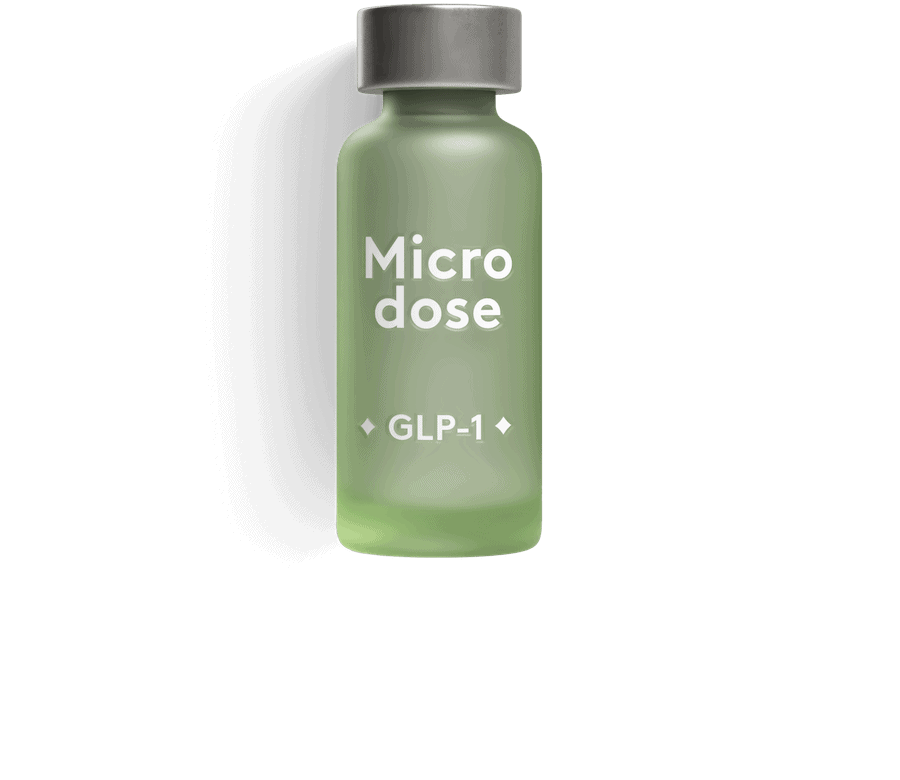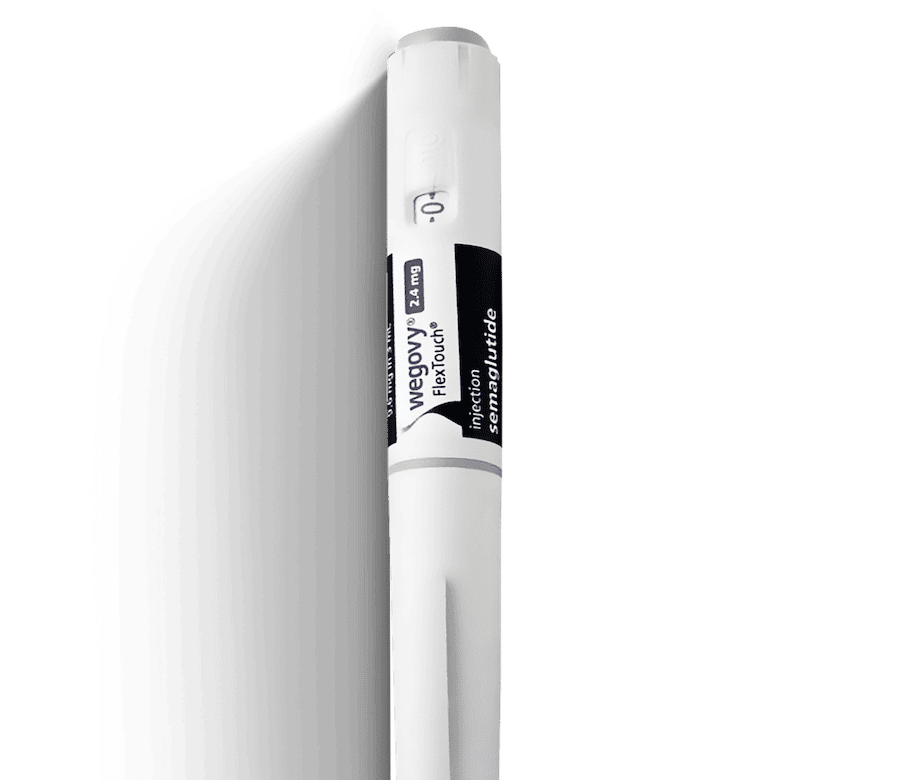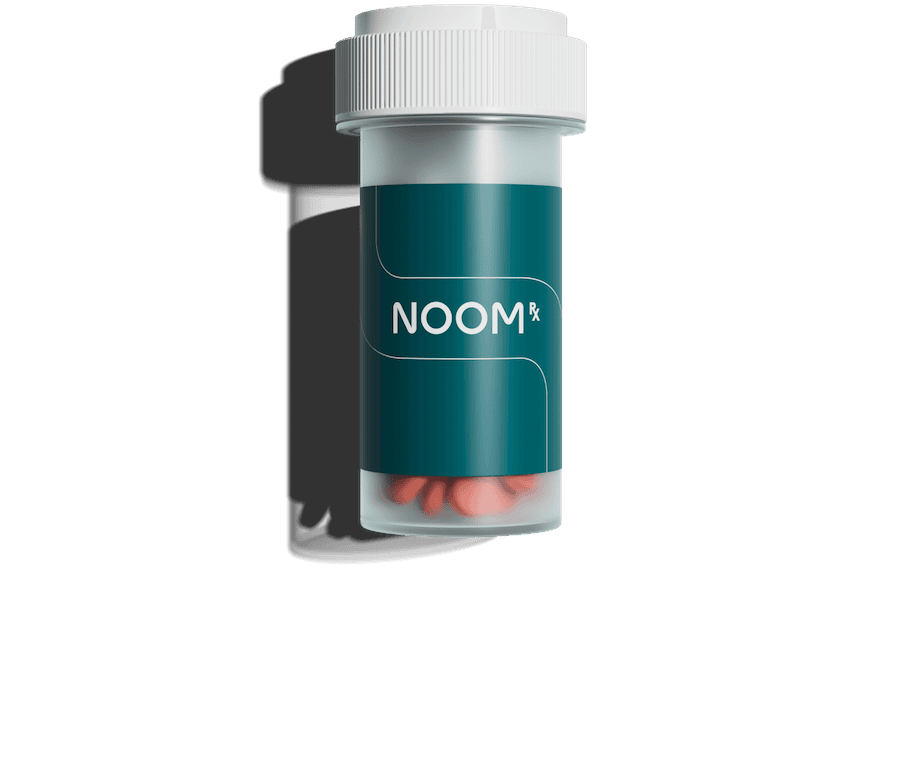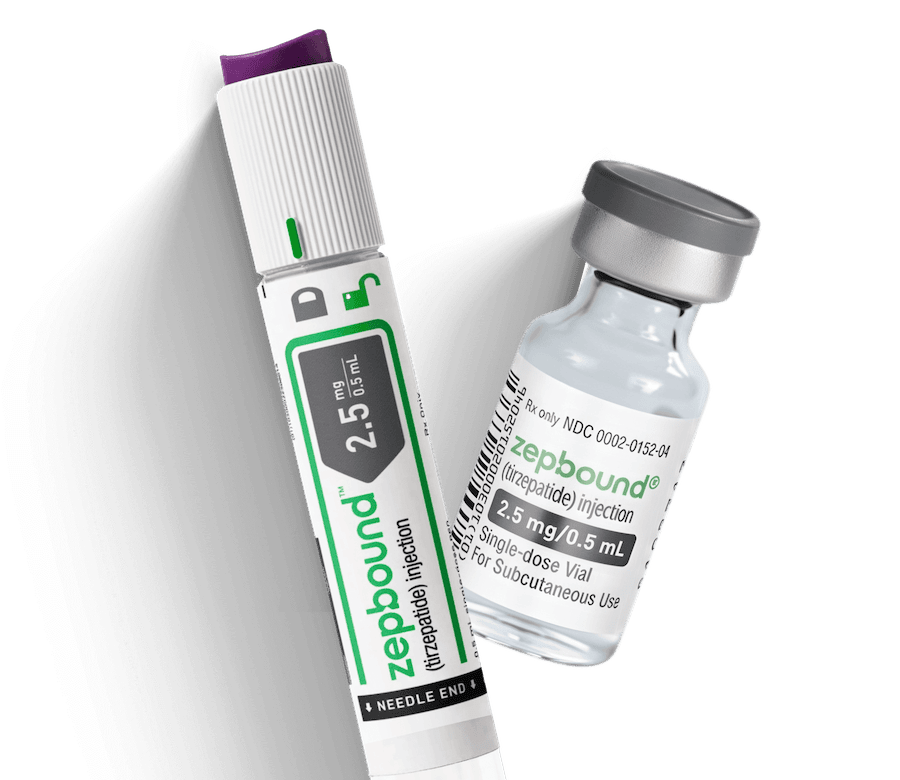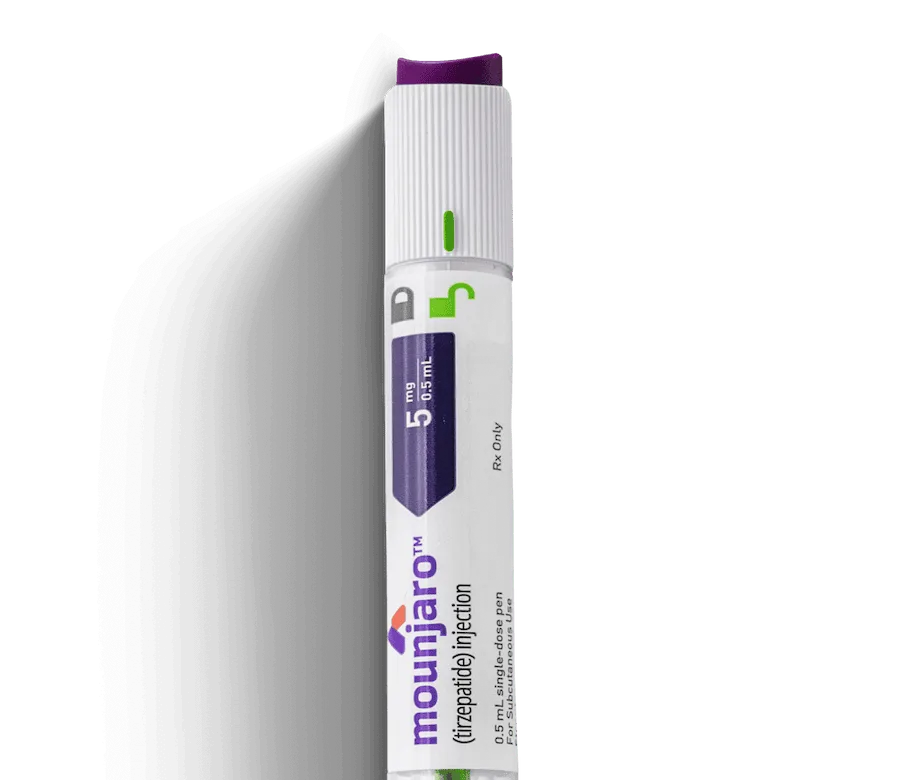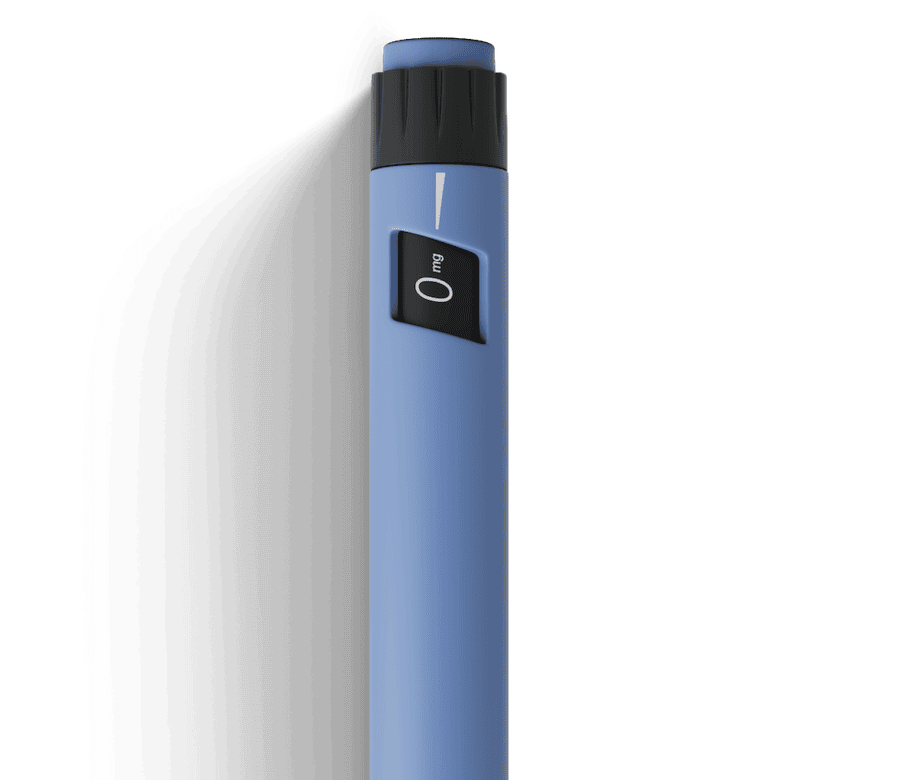- Mounjaro vs. Saxenda: What are they approved for?
- Mounjaro vs. Saxenda: How do they work?
- Mounjaro vs. Saxenda: What are the differences?
- Mounjaro vs. Saxenda: What are the similarities?
- Mounjaro vs. Saxenda: Which is better for weight loss?
- Who can take Mounjaro or Saxenda for weight loss?
- Saxenda vs. Mounjaro: Costs and insurance
- Mounjaro vs. Saxenda: Side effects and safety
- Which weight loss medication is right for me?
- Choosing between Mounjaro, Zepbound, and Saxenda
What you’ll learn:
- Mounjaro® (tirzepatide) generally leads to greater average weight loss with off-label use compared to Saxenda® (liraglutide), which is FDA-approved for weight loss.
- Mounjaro is injected once a week, while Saxenda is injected once per day.
- For weight loss, Zepbound®, Mounjaro®’s sister medication, approved for weight loss, can be a more affordable and effective option.
Losing weight isn’t always as simple as eating better and moving more. Aging, biology, certain medical conditions, and even stress and sleep (or lack of it) can all make it more challenging. Hormones shift, metabolism slows, and life gets in the way. Sometimes, even with the best efforts, the scale just won’t budge.
That’s why GLP-1 receptor agonists—a class of medications that help regulate appetite and blood sugar—have become so popular for weight loss. You’ve likely heard of Ozempic®, made with semaglutide, developed for diabetes but now sometimes prescribed off-label for weight loss. It paved the way for others, like Wegovy® (Ozempic’s counterpart for weight loss), tirzepatide medications (Zepbound® and Mounjaro®), and liraglutide medications (Saxenda® and Victoza®).
But what’s the difference? Today, we’ll compare Mounjaro® and Saxenda® to understand how they work, the similarities and differences, when they can be prescribed, how much weight a person can lose, and more.
Mounjaro® vs. Saxenda®: What are they approved for?
While you’ve likely heard about people, including celebrities like Amy Schumer, taking Mounjaro® for weight loss, it isn’t FDA-approved for that purpose. Weight loss is considered an off-label use. Its counterpart medication Zepbound® is approved for weight loss and is prescribed in the exact same doses of tirzepatide.
Saxenda®, made with liraglutide, is FDA-approved specifically for weight loss. Victoza® is the version of liraglutide that is approved for diabetes treatment.
These similarities can be confusing, but understanding the differences in dosing and approval can help you and your clinician choose what fits best into your lifestyle.
Mounjaro® vs. Saxenda®: How do they work?
It’s true that Mounjaro® and Saxenda® are both GLP-1 medications, but they work in slightly different ways. These drugs both mimic hormones that influence appetite, digestion, and regulate blood sugar. Let’s take a close look.
- Mounjaro® (tirzepatide) acts on two hormone pathways: GLP-1 and GIP receptors. This dual-action approach can lead to stronger appetite control and improved blood sugar regulation than medications that act on just GLP-1. Again, Zepbound® works the same way.
- Saxenda® (liraglutide) works by targeting the GLP-1 receptor alone. This single pathway still helps manage appetite, slows digestion, and supports better blood sugar. While it doesn’t include the additional GIP pathway like Mounjaro® and Zepbound®, Saxenda still offers support for people who need help managing hunger and building sustainable weight loss habits.
Mounjaro® vs. Saxenda®: What are the differences?
Mounjaro® and Saxenda®, while in the same family, are very different medications. Let’s take a look at the key differences.
Their active ingredients are different but related
While both are considered GLP-1 receptor agonists, which means they mimic GLP-1, Mounjaro® contains tirzepatide, which also mimics GIP. Saxenda®’s active ingredient, liraglutide, mimics the GLP-1 hormone only.
They’re both taken as an injection, but in different intervals
Both of these medications are delivered through injections that you give yourself, but the biggest difference is how often you use them. Mounjaro is injected once a week, thanks to its longer-lasting effects. Meanwhile, Saxenda® must be injected daily because liraglutide doesn’t stay active in the body as long as tirzepatide.
They have different FDA approvals
- Saxenda® is FDA-approved as a weight loss medication.
- Mounjaro® is approved for type 2 diabetes, but is often prescribed off-label for weight loss. Zepbound®, which contains the same active ingredient, is approved for weight loss.
Saxenda has a generic version
Saxenda®’s active ingredient, liraglutide, is available as a generic, which may make it more affordable for some people. The price for generic liraglutide is around $193 to $505 for a 2-pen package and around $280 to $753 for a 3-pen package. Mounjaro® doesn’t have a generic version. Learn more about the dosing of Saxenda and how many packages you will typically need per month.
Mounjaro® vs. Saxenda®: What are the similarities?
Although Mounjaro® and Saxenda® have some important differences, they share several key traits. Understanding these similarities can help you better prepare for what to expect if you’re considering either option.
Both are GLP-1 medications
As we mentioned, both Mounjaro® (tirzepatide) and Saxenda® (liraglutide) belong to the GLP-1 medication class, helping lower appetite, slow digestion, and regulate blood sugar.
Both require a slow increase in dose
Both medications are started at a low dose that’s gradually increased over time to help your body adjust and reduce side effects like nausea or stomach discomfort. This titration approach lets your system adapt to changes in digestion, appetite, and blood sugar regulation.
- Saxenda® (liraglutide): The dose typically starts at 0.6 mg once daily, increasing by 0.6 mg each week until reaching the standard maintenance dose of 3.0 mg daily.
- Mounjaro® (tirzepatide): The dose usually begins at 2.5 mg once weekly, then increases every four weeks (to 5 mg, 7.5 mg, 10 mg, 12.5 mg, and finally 15 mg) if tolerated. If you are taking Zepbound®, the increase will follow the same pattern.
Your healthcare provider may adjust the pace of these increases based on how you respond. Some people find success staying at a lower dose if they’re seeing steady weight loss and feel comfortable with their side effects. The goal is to find the lowest effective dose that supports your progress and feels sustainable long term.
Similar side effects
The most common side effects with both Mounjaro® and Saxenda® are mild digestive issues such as nausea, diarrhea, or constipation. These usually appear early in treatment or when the dose is increased, and improve over time.
More serious side effects can happen with either medication and are generally similar, because both liraglutide and tirzepatide work through the same GLP-1 pathway in the body. These may include inflammation of the pancreas (pancreatitis), changes in vision, gallbladder issues, or kidney problems. Learn more about the side effects of Mounjaro® and the side effects of Saxenda®.
High cost and insurance coverage
Both medications can be expensive without insurance, often costing over $1,000 per month. Coverage can vary depending on your plan and whether the drug is being prescribed for weight loss or another condition.
- Mounjaro® is FDA-approved for type 2 diabetes, so it may be covered if it’s prescribed for that condition. If it’s being used for weight loss, coverage is much less likely. That’s because most insurance plans don’t cover weight loss medications, even when they’re FDA-approved for that purpose.
- Saxenda® is also unlikely to be covered since it’s used for weight loss.
We’ll take a closer look at pricing later on, including ways to save on these medications through manufacturer coupons, savings programs, or other cost-reduction options.
Mounjaro® vs. Saxenda®: Which is better for weight loss?
When it comes to weight loss, Mounjaro® generally delivers stronger results than Saxenda®. For most people looking for more substantial weight loss results, Mounjaro® tends to be the more effective medication overall. But, since Mounjaro® is approved for diabetes, the best option for someone looking for weight loss support is likely to be Zepbound®.
How much weight can you lose with Mounjaro® vs Saxenda®?
When looking at weight loss with Mounjaro® and Saxenda®, clinical studies show clear differences in how much people typically lose over time. Both medications work best when paired with healthy eating, regular activity, and ongoing support, but the results seen in research can help set realistic expectations:
- Mounjaro®: People taking Mounjaro® lost an average of 21% of their body weight over 72 weeks. Again, the results are the same with Zepbound because the medications are prescribed in the exact same doses of tirzepatide.
- Saxenda®: In a year-long study, people taking liraglutide lost around 10% of their body weight.
How long does it take to see results?
When you’ll start seeing weight changes with these medications is one of the most common questions people have. The timeline varies from person to person, but here’s a general idea of what to expect and when.
Short-term results (3 months)
Continued progress (6 months)
Long-term results (12+ months)
Who can take Mounjaro® or Saxenda® for weight loss?
These medications are prescribed based on specific health criteria to make sure they’re both safe and effective for your situation.
You may be eligible for either medication for weight loss if:
- You have a body mass index (BMI) of 30 or higher
or
- You have a BMI of 27 or higher, along with a weight-related condition such as high blood pressure or high cholesterol
If you’re considering one of these medications, or Zepbound®, working with a medical team can help ensure you get personalized support and safe, effective treatment.
Who can’t take Mounjaro® or Saxenda®?
While Mounjaro® and Saxenda® can be effective tools for weight management or blood sugar control, they’re not suitable for everyone. Certain health conditions or risk factors may make these medications unsafe or require closer medical supervision. It’s important to talk with a healthcare provider to make sure they’re the right fit.
You shouldn’t take Mounjaro®, Zepbound®, or Saxenda® if:
- You or a family member has a history of medullary thyroid carcinoma (MTC)
- You have multiple endocrine neoplasia syndrome type 2 (MEN 2)
- You are pregnant or planning to become pregnant
- You are breastfeeding
- You’ve had a serious allergic reaction to liraglutide or tirzepatide.
Talk to your doctor about whether Saxenda® or Mounjaro®/Zepbound® is right for you if you:
- Have a history of pancreatitis
- Have severe gastrointestinal issues, such as gastroparesis (delayed stomach emptying)
- Are taking insulin or sulfonylureas, as these may increase your risk of low blood sugar
If you take Saxenda® or Mounjaro®/Zepbound® to lose weight, will you need to keep taking them forever?
No, you don’t necessarily have to stay on Saxenda® or Mounjaro® forever. How long you use these medications depends on your personal goals, how well the treatment works for you, and the healthy habits you build along the way. For some people, these medications are a short-term tool. For others, longer use may help maintain results.
Here’s what the research and clinical experience show:
- Typical treatment lasts 6 months to 2 years. Many people stay on GLP-1 medications for this time frame, though some continue longer if the benefits outweigh the costs and side effects.
- Weight regain is common after stopping. Many people regain a portion of the weight they lost within a year of discontinuing treatment if they don’t have strong lifestyle habits in place.
- Tapering may or may not be needed. Saxenda can usually be stopped without tapering. Mounjaro and Zepbound, on the other hand, may require a gradual reduction in dose to help minimize digestive side effects and allow your body to adjust. Your healthcare provider will guide this process.
- Behavioral support makes a difference. People who continue to follow a structured plan—like a balanced nutrition and behavior change program—are more likely to keep weight off after stopping medication.
Can you switch between Mounjaro®/Zepbound® and Saxenda®?
Yes, switching between them is possible, but it should always be done with the help of your healthcare provider. These medications work differently in your body, so transitioning between them requires a thoughtful plan. Your provider will help adjust your dosing and timing to make sure the change is as smooth as possible.
People choose to switch from one medication to another for a variety of reasons, including:
- Insurance coverage or cost changes that make one option more affordable than the other.
- Dosing convenience, such as preferring a weekly injection over daily shots or vice versa.
- Side effect management if one medication causes persistent discomfort.
- Personal preference based on how the medication fits into daily routines.
- Access or availability issues when one medication becomes harder to get.
When you switch, it’s normal to notice some differences in how your body responds. Because the medications work in slightly different ways, your appetite and weight loss pattern may change. You might feel shifts in hunger levels, how full you get after eating, or how your digestion feels. Some people experience mild nausea or stomach upset during the adjustment period, but this often improves as the body adapts.
Rx weight loss, the right way, with Noom
Get access to prescription weight loss medication with Noom.Saxenda® vs. Mounjaro®: Costs and insurance
Both Saxenda® and Mounjaro® are costly, especially without insurance, and figuring out what you’ll actually pay can feel confusing at first. While the list prices are high, there are ways to bring those costs down through insurance coverage, savings programs, or patient assistance options.
Here’s what you can expect in terms of pricing:
- Saxenda®: The list price for a month’s supply of Saxenda® is about $1,350. But your out-of-pocket cost may vary depending on factors like insurance coverage, pharmacy discounts, and manufacturer savings programs. There’s also a generic version of liraglutide available that costs $193 to $505 for a 2-pen package and $280 to $753 for a 3-pen package.
- Mounjaro®: Mounjaro® costs about $1,080 per month without insurance. Insurance coverage is usually limited to diabetes-related use.
- Zepbound® might be a more affordable option. While the prefilled pen version of Zepbound® costs about the same as Mounjaro®, if you get the vial and syringe form through LillyDirect, you’ll pay less. Here’s a look at pricing:
- The 2.5 mg starting dose of Zepbound® costs $349 per month
- The 5, 7.5, 10, 12.5, and 15 mg doses cost $499.
- Zepbound® might be a more affordable option. While the prefilled pen version of Zepbound® costs about the same as Mounjaro®, if you get the vial and syringe form through LillyDirect, you’ll pay less. Here’s a look at pricing:
Mounjaro® vs. Saxenda®: Side effects and safety
Most people experience mild to moderate side effects when starting Mounjaro® or Saxenda®, especially as the body adjusts to the medication, including:
- Nausea
- Diarrhea
- Constipation
- Vomiting
Serious side effects and warnings
While rare, some side effects of GLP-1 medications are more severe. If you experience signs of any of these conditions while taking Mounjaro® or Saxenda®, get immediate medical attention.
- Pancreatitis: Symptoms include severe abdominal pain that radiates to your back, with or without vomiting.
- Vision changes: If you notice any sudden changes in your vision while taking these, get immediate medical attention.
- Low blood sugar (hypoglycemia): Low blood sugar is most likely in people who are also taking medications for diabetes. Symptoms include dizziness, shakiness, blurred vision, and a fast heartbeat.
- Kidney problems: Diarrhea, nausea, and vomiting can cause dehydration and worsen kidney issues. Go to the ER if you experience decreased urination, swelling in the ankles or legs, fatigue, or shortness of breath.
- Gallbladder problems: If you experience upper abdominal pain, fever, jaundice, or clay-colored stools, get immediate medical attention.
- Allergic reactions: Symptoms include swelling of the face, lips, tongue, or throat, difficulty breathing or swallowing, or a rapid heartbeat. Get immediate medical attention if you’re having an allergic reaction.
- Thyroid tumors and cancer: Although this risk has only been seen in animal studies, it’s important to stay alert for any unusual symptoms such as a lump or swelling in your neck, hoarseness, trouble swallowing, or shortness of breath.
Learn more about the side effects of Mounjaro and Saxenda.
Choosing Between Saxenda® or Mounjaro® and Zepbound®: Which is right for me?
When making a Saxenda® or Mounjaro® comparison, the right choice varies for each person. Here’s what to consider when weighing your options:
| Medication | Saxenda® | Mounjaro®/Zepbound® |
|---|---|---|
| Effectiveness | People lost about 10% of their body weight over 52 weeks. | People lost an average of 21% of body weight at 72 weeks. |
| Administration | A once-daily injection given in the stomach, thigh, or upper arm using a prefilled pen. | A once-weekly injection given in the stomach, thigh, or upper arm using a prefilled pen or a vial and syringe. |
| Pricing per month (without insurance) | Saxenda®: $1,350 Learn more. Generic liraglutide: 2-pen package: $193 to $505 3-pen package: $280 to $753 Learn more. | Mounjaro®: $1,080 Zepbound®: Pens: $1,087 Vials: $349 (2.5 mg) $499 (5 mg, 7.5 mg, 10 mg, 12.5 mg, and 15 mg) Learn more |
| Active ingredient | Liraglutide | Tirzepatide |
| FDA approval and uses | Saxenda®: FDA-approved for weight management Generic liraglutide: Approved for diabetes and weight loss | Mounjaro®: FDA-approved for type 2 diabetes; off-label for weight loss Zepbound®: FDA-approved for weight loss and obstructive sleep apnea (OSA) |
| Manufacturer | Novo Nordisk | Eli Lilly |
| Insurance coverage | Saxenda® & generic liraglutide: Unlikely to be covered for weight loss | Mounjaro®: Might be covered for diabetes; unlikely for weight loss Zepbound®: Unlikely to be covered for weight loss |
Alternatives to Mounjaro®/Zepbound® and Saxenda®
If Mounjaro® or Saxenda® aren’t the right fit for you, several other FDA-approved medications can support your weight management goals. These alternatives are organized by their active ingredients, which can help you and your provider understand how they might work differently for your specific situation.
| Medication | Brand names and uses | Cost per month (without insurance) | Effectiveness | How it’s taken |
|---|---|---|---|---|
| Semaglutide | Ozempic®: type 2 diabetes, off-label weight loss Wegovy®: weight loss and heart disease Rybelsus®: type 2 diabetes, off-label weight loss | Ozempic®: $998 Learn more Wegovy®: $1,350 $499 (NovoCare Pharmacy) Learn more Rybelsus®: $998 Learn more | Ozempic®/Wegovy®: People lost an average of 15% of body weight in 68 weeks with injectable semaglutide. Rybelsus®: People lost around 4% of their body weight over 26 weeks. | Ozempic®/Wegovy®: Weekly injection Rybelsus®: Daily pill |
Other medications
While GLP-1 medications are popular, they’re not your only option. Other treatments are available that work in their own way to support weight loss.
| Medication | Brand names | Cost per month (without insurance) | Effectiveness | How it’s taken |
| Metformin (off-label weight loss) | Glucophage®, Fortamet®, Glumetza® | Generic: $4–$15 Brand name: $100–$500+ Learn more. | People lost an average of about 6% of their body weight over six months while taking metformin. | Pill taken up to two times daily |
| Phentermine | Lomaira®, Adipex-P® | $27-$100 | About 80% of people with a BMI of 30 or more lost at least 5% of their body weight in 6 months. | Daily pill |
| Diethylpropion | Tenuate®, Tenuate Dospan® | $40-$85 | People lost an average of 10% of their body weight in 6 months. | Pill taken one to three times daily |
| Naltrexone and bupropion | Contrave® | $600-$800 CurAccess™: $99 | People lost an average of 7 to 8% of their body weight in a year. | Pill taken up to twice daily |
| Orlistat | Xenical®, Alli® | $50-$800 | People in a study lost about 10% of body weight after taking Orlistat for 1 year. | Pill taken three times daily with meals. |
Sign up for Noom Digest!
Stay on top of your wellness journey with the latest Noom news, thoughtful articles, and a healthy dose of inspiration delivered right to your inbox.Choosing between Mounjaro®, Zepbound®, and Saxenda®
Mounjaro®, Zepbound®, and. Saxenda® can all help you lose weight, but the best choice depends on your unique needs and goals. Factors like your health history, insurance coverage, dosing preferences, and personal lifestyle will help determine which one may fit best.
Mounjaro® and Zepbound® have shown greater average weight loss in clinical studies, an average of 21%, versus Saxenda’s 10%. But how your body responds to side effects will be an important factor as to which works best for you.
Ultimately, both options can be effective when paired with healthy habits. The most successful long-term outcomes happen when medication is combined with sustainable nutrition and behavioral changes, giving you the best chance at lasting results.
If you’re considering either option, see if you qualify for Noom Med. You’ll be connected with licensed clinicians who can guide you through your choices and pair prescription support, if needed, with proven, psychology-based tools.
Note: Mounjaro®, Ozempic®, Rybelsus®, and metformin are not FDA-approved to treat obesity or for weight loss.
Why you can trust us
At Noom, we’re committed to providing health information that’s grounded in reliable science and expert review. Our content is created with the support of qualified professionals and based on well-established research from trusted medical and scientific organizations. Learn more about the experts behind our content on our Health Expert Team page.



